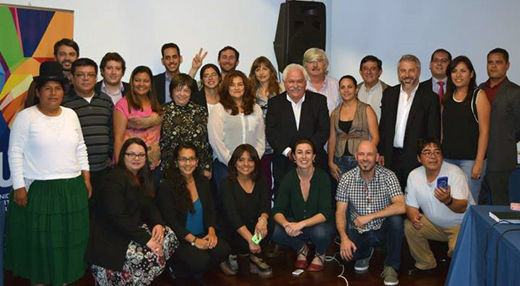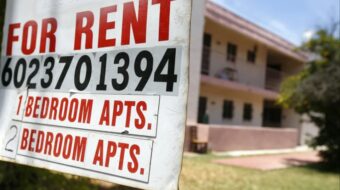
This past November 4-5, Latin America celebrated the 10th anniversary of the Fourth Summit of the Americas, carried out in Mar de Plata, Argentina in 2005, and of the concomitant Third People’s Summit. At Mar de Plata, U.S. President George W. Bush, Canadian Prime Minister Paul Martin and Mexican President Vicente Fox Quezada arrogantly tried to change the agenda from a planned focus on social welfare to one of imposing the neo-liberal Free Trade Area of the Americas, the North American Free Trade Agreement (NAFTA) expanded to include all the other countries in the region.
Instead of passively accepting the imperial dictates, the host of the Summit of the Americas, Argentine President Nestor Kirchner, Brazilian President Luis Inacio Lula da Silva, Uruguayan President Tabare Vazquez and Venezuelan President Hugo Chavez sent them to blazes with fiery denunciations. As Chavez put it, they sent the ALCA (Area de Libre Comercio Americana, as the FTAA is called in Spanish) “al carajo.” [to hell]
The meeting broke up without any action on the FTAA, and the basis was formed for the expansion of the nucleus of the Bolivarian movement to encompass a much larger number of countries in Latin America and the Caribbean behind a program that rejects the neo-liberal Washington consensus and domination by multinational corporations and the United States while emphasizing multinational cooperation to end poverty, inequality, illiteracy, preventable diseases, racial and gender discrimination and environmental degradation.
ALBA or Bolivarian Alliance for the Peoples of our America, which originally encompassed only Cuba and Venezuela, came to include also Antigua, Bolivia, Dominica, Ecuador, Grenada, Nicaragua, St. Lucia, St. Kitts and Nevis and St. Vincent and the Grenadines (Honduras withdrew after a U.S. supported military coup in 2009).
A wider group of countries were integrated into the “Bolivarian pink tide” of left and left center governments through UNASUR and the expansion of the trade group MERCOSUR and other mechanisms: Argentina, Brazil, Chile, El Salvador Guyana, Paraguay, Suriname and Uruguay. The capstone of the Bolivarian success was the creation of CELAC, the Community of States of Latin America and the Caribbean, which includes all Western Hemisphere countries except – by design – the United States and Canada. CELAC is seen by many as a potential replacement for the venerable Organization of American States (OAS) which is perceived as an instrument of U.S. regional domination.
Countries in the region left out of the main aspects of the Bolivarian process have included Mexico, Guatemala, Honduras (after the 2009 coup), Costa Rica, Panama, Colombia, Peru, Paraguay (after a “constitutional coup” in 2012), Bahamas, Barbados, Belize, Dominican Republic, Haiti, Jamaica and Trinidad and Tobago, as well as non-sovereign countries such as Puerto Rico, the U.S. Virgin Islands and remaining European colonies. Yet many of the countries that are not politically part of the Bolivarian group benefit from some of its programs, especially PETROCARIBE which has been providing fuel to them on very favorable terms.
The Bolivarian countries have made great advances in fighting poverty, inequality and racial and gender discrimination as well as improving schools, health care and housing for their people. They also played a major role in pressuring the United States to change its 50 year plus anti-Cuba policy, making clear that if this continued it might spell the end of the OAS.
Recently, some key Bolivarian “pink tide” countries have been experiencing difficulties. On November 5, the right wing candidate, Mauricio Macri, won the presidential election in Argentina, displacing the left wing coalition that had brought presidents Nestor Kirchner and Cristina Fernandez de Kirchner to power.
Earlier this year, a similar thing happened in Guyana. On December 6 there is a parliamentary election in Venezuela. That country has been experiencing an economic slump caused mainly by the drastic worldwide drop in the price of its chief export, oil, along with some instability, and this may cut into the ruling left-wing alliance’s results or lose it the majority entirely, creating big difficulties for President Nicolas Maduro’s progressive economic and social policies. There are serious problems in Brazil and Chile.
These negative developments have led to hand-wringing by some on the left, as well as undisguised glee on the right, which see this situation as a harbinger of the return of the FTAA in the form of the Transpacific Partnership (TPP). But others say it is too early to write off the Bolivarian approach and herald a region-wide return of full blast neo-liberal policies of free trade, deregulation, privatization, austerity and repression.
First of all, the electoral victories of the right in Argentina and Guyana were by very small margins, and it will be very difficult for those governments to dismantle progressive programs created by their predecessors with wide popular support.
Secondly, not a single major non-Bolivarian Latin American or Caribbean country is doing well economically or socially. In an earlier article, I pointed out some inherent difficulties faced by the Bolivarian project in a world still dominated by international corporate monopolies and imperial hegemony. These things impede the Bolivarian project but also the development efforts of the non-Bolivarian states, in some cases to an even worse degree because the states are themselves weakened by their subordination to corporate and U.S. power.
Mexico is in the throes of multiple economic and social crises. It is seeing an increase in inequality and poverty as well as crises of personal security, crime and corruption. The right wing, neo-liberal government of President Enrique Peña Nieto is deeply distrusted and reforms he has been promoting in the sectors of petroleum and education have either failed or caused massive strife.
Guatemala is a basket case. After a bloody civil war that lasted more than three decades and saw the massacre of more than 200,000 people, including large numbers of indigenous Mayas, Guatemala seems unable to get out from under the combined domination of fascistic militarists and corrupt political cliques connected to the international drug trade. The latest is that the health care system in Guatemala is near collapse because corrupt administrators have looted its funds.
Honduras has become poorer, more corrupt and more violent since the overthrow of left-wing President Manuel Zelaya in June of 2009. The world financial crisis that started in the United States in 2008 was certainly no help, but post Zelaya governments also imposed austerity, privatization and repression policies which, along with a mind boggling level of corruption, have made things much worse for ordinary Honduran workers, farmers and others.
Costa Rica has major labor conflicts and repression. The former president of Panama is being sought for extradition on charges of massive corruption. Paraguay, since the 2012 ouster of President Fernando Lugo, has seen a sharp increase in social conflict as multinational agribusiness, abetted by right-wing President Horacio Cartes, has moved in on the smallholdings of peasant farmers leading to militant protests and the left just won the municipal elections in the capital, Asuncion. In Peru, conflicts between indigenous farmers and abusive foreign mining companies have become the order of the day.
The Dominican Republic is wracked by corruption and the government of President Danilo Medina seeks to distract attention, in the lead up to presidential elections in May of 2015, by lashing out at Haitian immigrants and Dominican born people of Haitian descent, threatening them with massive deportation. Haiti itself just got through a very dubious election whose turnout was extremely low and whose results are suspected by many. It is likely to remain the poorest country in the Western Hemisphere.
Among the non-Bolivarian nations, the only bright spot is Colombia, where negotiations between the government of conservative President Manuel Santos and the left-wing guerrillas of the Armed Forces of the Colombian Revolution-People’s Army (FARC-EP) in Spanish seem to be proceeding well. But the Colombian ultra-right, headed by ex President Alvaro Uribe, is doing everything it can to sabotage the peace talks.
In most of the non-Bolivarian countries the political left is relatively weak. But social movements of workers, farmers, women, youth and indigenous and Afro-descended people are strong and in many cases consciously see themselves as linked to the Bolivarian movement. And this is true of the Bolivarian countries as well. The Bolivarian project does not depend on specific leaders or political parties alone, but much more on an organized and mobilized social base which will not sit idly by while all that they have achieved is simply negated at the behest of imperial hegemony and transnational monopoly capital.
Photo: Nov. 11 in Montivideo, Uruguay, two days of meetings between representatives of social movements, states parties and institutions: With Rafael Reis, Eliana Zavarce, Rafael Alvariza, Coordinadora De Centrales Sindicales Del Cono Sur, IPPDH MERCOSUR, Andressa Caldas, UPS Mercosur, Redes-at Uruguay, Murilo Vieira Komniski, REAF MERCOSUR and Colin Cadier. Secretaría MERCOSUR, Facebook page.












Comments